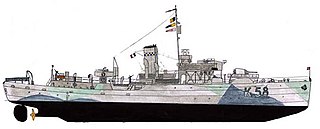
Aconit was one of the nine Flower-class corvettes lent by the Royal Navy to the Free French Naval Forces. During World War II, she escorted 116 convoys, spending 728 days at sea. She was awarded the Croix de la Libération and the Croix de Guerre 1939–1945, and was cited by the British Admiralty. Following the war she was used as whaling ship for three different companies from 1947 to 1964.

HMS Mallow was a Flower-class corvette commissioned into the Royal Navy that served as a convoy escort during World War II; with the Royal Navy in 1940–1944, and with the Royal Yugoslav Navy-in-exile in 1944–1945. In Yugoslav service she was renamed Nada. Her main armament was a single 4-inch (102 mm) Mk IX naval gun, although a significant number of secondary and anti-aircraft guns were added towards the end of the war. During the war she escorted a total of 80 convoys whilst in British service, sinking one German U-boat, and escorted another 18 convoys whilst in Yugoslav service. After the war she served in the fledgling Yugoslav Navy as Nada then Partizanka, before being returned to the Royal Navy in 1949. Later that year she was transferred to the Egyptian Navy in which she served as El Sudan until she was decommissioned in 1975.
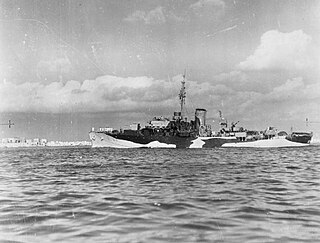
HMS Bryony was a Flower-class corvette that served in the Royal Navy and Royal Norwegian Navy.
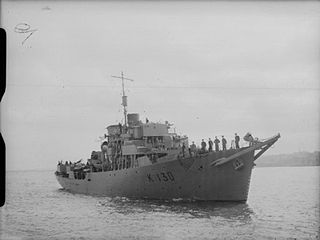
HMS Lotus was a Flower-class corvette that served in the Royal Navy.

Mid-Ocean Escort Force (MOEF) referred to the organisation of anti-submarine escorts for World War II trade convoys between Canada and Newfoundland, and the British Isles. The allocation of United States, British and Canadian escorts to these convoys reflected preferences of the United States upon United States' declaration of war and the organisation persisted through the winter of 1942–43 despite withdrawal of United States ships from the escort groups. By the summer of 1943, United States Atlantic escorts were focused on the faster CU convoys and the UG convoys between Chesapeake Bay and the Mediterranean Sea; and only British and Canadian escorts remained on the HX, SC and ON convoys.
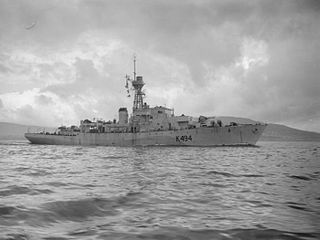
HMS Rising Castle was a Castle-class corvette built for the Royal Navy in World War II. She was named for Castle Rising in Norfolk, England. Before she was commissioned she was transferred to the Royal Canadian Navy and renamed Arnprior and given a new pennant number. After the war she was sold to Uruguay and renamed Montevideo.
HMS Arabis was a Flower-class corvette of the Royal Navy. The ship was commissioned into the Royal Navy as HMS Arabis. She was transferred to the United States Navy in 1942, serving as USS Saucy. Returned to the United Kingdom in 1945, she was recommissioned into the Royal Navy as HMS Snapdragon.

HMS Spiraea was a Flower-class corvette of the British Royal Navy. Named for a genus of shrub, Spiraea served in the Second World War as an escort.
Escort Group B7 was a British formation of the Royal Navy which saw action during the Second World War; principally in the Battle of the Atlantic.
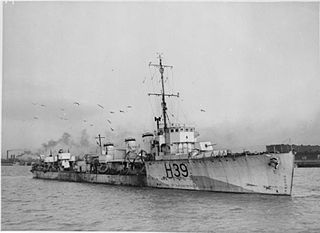
An Escort Group consisted of several small warships organized and trained to operate together protecting trade convoys. Escort groups were a World War II tactical innovation in anti-submarine warfare by the Royal Navy to combat the threat of the Kriegsmarine's "wolfpack" tactics. Early escort groups often contained destroyers, sloops, naval trawlers and, later, corvettes of differing specifications lacking the ability to maneuver together as a flotilla of similar warships, but rigorously trained in anti-submarine tactics to use teamwork emphasizing the unique sensors, weapons, speed, and turning radius of each ship. The development of these 'escort groups' proved an effective means of defending shipping convoys through the Battle of the Atlantic.
Escort Group B6 was a British convoy escort group of the Royal Navy which saw action during the Second World War, principally in the Battle of the Atlantic.
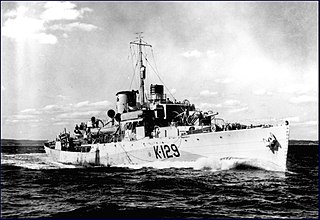
HMCS Agassiz was a Flower-class corvette of the Royal Canadian Navy. Named after the community of Agassiz, British Columbia, the ship was constructed by Burrard Dry Dock Co. Ltd. in North Vancouver, British Columbia and was launched on 15 August 1940. The corvette was commissioned on 23 January 1941 in Vancouver, British Columbia. The Flower class were initially designed for coastal service during the Second World War, but due to the demands of the Battle of the Atlantic, Agassiz was used primarily as an ocean escort for convoys crossing the Atlantic Ocean in engagements with German submarines. Following the war, the corvette was sold for scrap.

HMCS Battleford was a Flower-class corvette of the Royal Canadian Navy launched on 15 April 1940 and commissioned on 31 July 1941 during the Second World War. The corvette served primarily in the Battle of the Atlantic, escorting convoys of merchant ships. After the war she was sold to the Venezuelan Navy and renamed Libertad. Libertad was wrecked on 12 April 1949.

HMCS Napanee was a Flower-class corvette of the Royal Canadian Navy during the Second World War. She saw service primarily in the Battle of the Atlantic as a convoy escort. She is named after Napanee, Ontario.

HMCS Shediac was a Flower-class corvette of the Royal Canadian Navy during the Second World War. She served primarily in the Battle of the Atlantic as a convoy escort. She was named after the town of Shediac, New Brunswick.

HMCS Chambly was a Flower-class corvette serving in the Royal Canadian Navy. She was ordered from Canadian Vickers Ltd. in Montreal, laid down on 20 February 1940, launched on 29 July, and commissioned on 18 December 1940, named after the city of Chambly, Quebec. Chambly escorted trade convoys between Halifax Harbour and the Western Approaches through the battle of the Atlantic and, together with HMCS Moose Jaw, achieved the RCN's first U-boat kill of the war.
HMS Calendula was a Flower-class corvette, built for the Royal Navy during the Second World War, and was in service in the Battle of the Atlantic. In 1942 she was transferred to the United States Navy as part of the reverse Lend Lease arrangement and renamed USS Ready, one of the Temptress-class gunboats. With the end of hostilities she was returned to the Royal Navy and sold into mercantile service.

HMCS Algoma was a Flower-class corvette that served with the Royal Canadian Navy in the Second World War. Named for the Algoma District of Ontario, it served primarily in the Battle of the Atlantic. After the war it was sold to the Venezuelan Navy and renamed Constitución.

HMS Sunflower was a Flower-class corvette of the Royal Navy. She served during the Second World War.

HMS Dianella was a Flower-class corvette of the Royal Navy. She served during the Second World War.

















